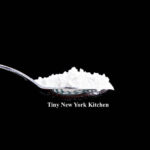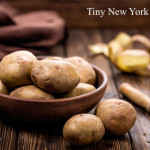Autumn’s bounty is vibrant, varied, and delicious. Apples of all varieties are now available at farmers’ markets and supermarkets, including crunchy, sweet Honeycrisp, gorgeous Galas, MacIntosh mottled with both green and red, pale yellow Ginger Golds, and dark, dusky Paula Reds.
Apples are the perfect snack, satisfying and sweet. Try slicing an apple, place the slices in a plastic baggie, sprinkle liberally with cinnamon, close the bag, and shake until the slices are well coated with cinnamon. The apple slices will stay crisp and white for several days in the refrigerator. Perfect for grab and go school lunches, picnics or work from home snack breaks.
A versatile cooking ingredient, apples go well with both sweet and savory components. Combing apples with plums, cranberries, figs, raspberries or blueberries will yield particularly pleasing desserts, such as pies, puddings, tarts, cobblers, and crisps. Whether baked, poached or sautéed, apples lend marvelous layers of flavor to breads, sauces, slaws, salads, stuffing, coleslaw, chutney, and relishes.
As the weather turns cooler, what could be more comforting than the scent of apples roasting in the oven, mingling with spicy cinnamon. Apples enjoy an easy association with all manner of spices, including allspice, cloves, ginger, and nutmeg.
©Tiny New York Kitchen © 2020 All Rights Reserved
5 Ways To Use A Vegetable Peeler
The humble vegetable peeler has hidden talents.
Easily Peel Fruit: To peel soft fruits and vegetables, like tomatoes and peaches, you usually have to briefly dunk them into boiling water. Using a good vegetable peeler is so much easier and faster. Look for peelers with serrated blades for the best results and select not-too-ripe fruit.
Shaved Cheese: Give salads, pastas and roasted vegetables a restaurant-style finish by garnishing with generous amounts of shaved Parmesan or pecorino romano cheese.
Vegetable Pasta: Shave long strips of zucchini, carrots (even sweet potatoes and squash) to transform them into pasta substitutes. Serve raw or briefly steamed with your favorite sauce, or toss with a vinaigrette for a fresh and nutritious salad.
Spreadable Butter: Is there anything worse than trying to butter toast or bread with rock hard butter straight from the fridge? Use a vegetable peeler to scrape off thin and perfectly spreadable butter ribbons.
Chocolate Curls: Peel the edge of a slightly softened chunk of chocolate to create curls, or the flat surface of very cold chocolate to make shavings. Keep your creations in the freezer and use to garnish cakes, pies, puddings and seasonal fruit.
www.tinynewyorkkitchen.com
“Work With What You Got!”
© Victoria Hart Glavin Tiny New York Kitchen © 2016 All Rights Reserved








